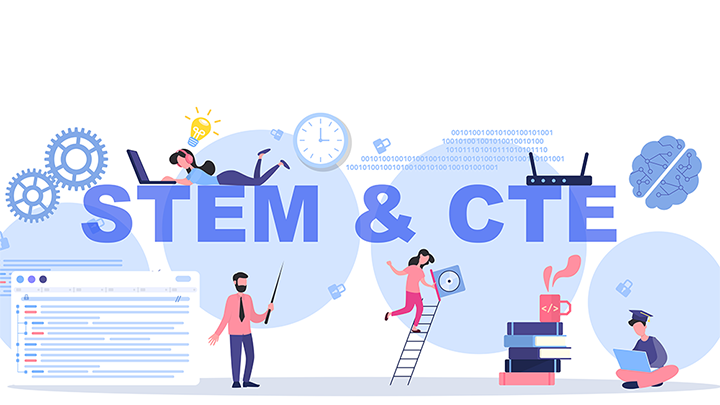Career and Technical Education (CTE) | STEM
CTE & STEM
From hands-on learning opportunities to on-the-job training and workforce exposure, there are many similarities between CTE and STEM education programs. Many educational institutions are increasing the skills of their learners in STEM, or science, technology, engineering and mathematics subject areas key to success in a tech-driven world. Schools and universities are rising to the challenge by providing challenging, pertinent CTE programs with a heavy emphasis on science, technology, engineering, and mathematics curriculum. Investing in the opportunity to provide STEM-rich CTE programs can help to prepare students to compete and succeed in the ever-changing global workforce.
CTE has always been a pioneer in fusing academics with technology. For example, CTE courses in nutrition, health care, and agriculture have traditionally included important science content and, in many cases, awarded students core academic credits. Over the past few years, schools throughout the country have introduced or expanded hundreds of brand-new, cutting-edge STEM-focused CTE programs. Allied CTE and STEM programs have the potential to assist a significant number of students in preparing for the future workforce. CTE and STEM programs are instrumental in giving students a deeper understanding of their available career pathways. They also work to increase student interest in CTE and STEM careers by making math and science content more applicable and concrete for students through integration.
CTE programs allow students to have a better understanding of the range of jobs related to STEM fields and the various routes that can lead to those careers. Merging CTE and STEM allows students to be exposed to learning and professions they may never have ever considered through courses in subjects including aviation and aerospace, information technology, engineering, game creation, health care, nanotechnology, simulation, and robots. The support services required to assist students in pursuing these demanding courses and career opportunities are integrated into CTE programs. These services include mentors, career and technical student organizations, and work-based learning opportunities like job shadowing and internships to connect young people with kind adult role models. Through career clusters, STEM courses are taught across CTE, providing students with a more comprehensive understanding of the world of careers and possibilities that await them after high school.
Through the intentional inclusion of STEM principles, CTE courses can improve all students' STEM literacy and raise the likelihood that these students would choose jobs in STEM and CTE fields. Most students are exceptional learners, but all students have very different learning styles.
Merging CTE and STEM allows students to grasp complex concepts in concrete, manageable, bite-sized learning experiences. Through CTE classes, students learn how STEM principles are directly applied to real-world circumstances and how valuable STEM and CTE knowledge and skills are in tackling real-world problems.

